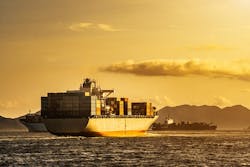You would be hard-pressed to find a tire dealership that has not been impacted in some way or another by the ongoing shipping crisis.
From extended delivery delays to sky-high freight rates, the slowdown continues to throw a monkey wrench into supply chains - and many dealers are shouldering the burden.
What’s happening today? When will the shipping crisis end? What can dealers do in the meantime? Martin Dixon, head of research products for Drewry - a global shipping industry consultancy with offices in the United Kingdom, China, India and Singapore - provides answers in this MTD exclusive.
Dixon has more than three decades of operational experience in international shipping and supply chain management. “There are things (dealers) can do” to help lessen the impact of the shipping crisis on their own businesses, he says.
Martin Dixon appeared on MTD's new podcast, The Modern Tire Dealer Show. Subscribe anywhere you listen to your favorite podcasts.
MTD: So many of our readers sell tires that are made in southeast Asia and depend on containers to arrive when they are supposed to. But what used to take 90 days to arrive now takes twice as long to arrive - and maybe more. Can you walk us through what’s happening and how we arrived at this point?
Dixon: In terms of the origin of what’s been causing this slowdown and the big spike in freight rates, it’s really all down to the disruptions caused by the COVID-19 pandemic.
The effect of that was firstly to make cargo volumes moved in ships extremely volatile, whereas normally, these volumes are much more easily predictable. And then coupled with that is that shipping lines’ response to this volatility has been to change their capacity of ships offered into the market.
And the effect of that has then stoked problems further down the line across the container supply chain, particularly in regard to the availability of shipping equipment - that is, the empty containers that are used to move the cargo.
The other thing to add here is that (in) many supply chains that tire manufacturers, ause it has had to. The very low freight rates that have been the case for over a decade have made the trade particularly unprofitable for some players and quite challenging, so therefore they’ve had to be lean. And the leanness of this container supply chain has been really tested during the COVID-19 pandemic.
MTD: And freight rates have spiked. Do you expect rates to remain elevated?
Dixon: Yes, we do - especially over the short-term. The cost to ship a 40-foot container from the port of Shanghai to the port of Los Angeles was typically around $1,500, pre-pandemic, and since then, the price of doing that now has increased four-fold to over $6,000. So there’s been a big increase in freight rates.
And if you look at the trade from Asia into Europe, the increase in freight rates there has been almost seven-fold, so it’s not just North American cargo owners who are feeling the pain.
The elevation in these freight rates is due to two things, principally. One has to do with the disruption we’ve seen since the start of the pandemic. But I think the other factor - which is very significant and has more longer-term implications for freight rates - is that carriers have become much better now at managing capacity.
The industry is far more concentrated, to the point where a small number of carriers control a large part of the market. And we think, therefore, that cargo owners need to face really what is a new normal of much higher freight rates to come.
We don’t think rates will necessarily rise much further over the next few years, but I think we are in an era where people will need to pay more money to ship cargo. I think there will be some drop-offs in some spot rates and some premium rates.
Cargo owners, in some cases, are paying $15,000 to $20,000 a box in order to secure particular sailings and secure particular equipment types. Expect to see some of these premium rates drop off, in time.
But I think that over the medium-term, we will not see a return to the $1,500-a-box rate that we saw, pre-pandemic.
MTD: You mentioned disruptions caused by the pandemic. Can you elaborate on that point?
Dixon: There’s been this perfect storm of a number of things that have come together at broadly the same time, although there has been some chronology to that.
In the first half of last year, we saw this very sharp contraction in trade as the global economy closed up due to COVID-19 lockdowns. And therefore in response to that, shipping lines significantly cut capacity. On some trade lanes, capacity was cut by as much as 30% through canceling sailings. And the effect of this was to heavily disrupt the recycling of shipping containers.
So if you look at most trade - particularly those that are heavily imbalanced, (like) the trade between Asia and North America - the lines need to recycle lots of empty containers back to Asia in order to have a sufficient number available to fill new cargo, because there isn’t enough trade moving from North America back to Asia.
That recycling of containers is critical in terms of maintaining the availability of containers. That was heavily disrupted. And that meant that when the trade recovered during the second half of last year - (which) was a very sharp and strong recovery - there were not enough shipping containers at the right place. And that was the start of the major constraints to available capacity.
At the same time, shipping lines were adding sailings in order to (accommodate) this big spike in cargo demand. Therefore, the impact later on - as you got more toward the end of the year - (was that) we started to see a build-up of congestion in ports. That was partly the effect of COVID-19 restricting some of the labor availability in these ports.
And also, ports are fairly rigid in terms of their capacity opportunity because they are highly capital-intensive and their ability to respond to a big change in shipping through-put is heavily constrained.
The impact, then, of reduced labor availability and the inability to scale up to meet this big spike in shipping demand is that (ports) became heavily congested. You had a lot of empty containers building up around the west coast of the U.S. and you had a huge shortage of containers back in Asia. So this created a gridlock in the system.
And to add to that, it’s not just purely what’s been happening on the supply side. Back along the inland supply chain, you’re seeing more and more congestion there, too, because the impact of COVID-19 on staffing levels has (impacted) trucking companies and warehousing companies. The confluence of all of these different factors happening broadly at once and to some extent, synchronized, has (had) quite a devastating effect on the supply chain.
MTD: Last summer, tire dealers reported a sharp increase in demand. They went from seeing very few cars in March and April, more vehicles during the month of May and then in June, everything went bonkers, which was great for their business. But it sounds like the shipping industry was not in a good position to react quickly to that spike.
Dixon: I think the degree of change in shipping demand was quite considerable. If you are running a highly asset-based business like ships or ports, it’s hard to scale up very quickly.
And I think probably initially, at least in the early stages - June to July of last year - carriers, to some extent, were holding back on releasing extra capacity into the market because they were still conscious of trying to hold onto the pricing gains they achieved during the course of the pandemic and the first half of the year.
Shipping had been plagued by overcapacity for a decade and that’s why it had been so cheap. There was an element of slowing the release of capacity. But I think all that was exacerbated by the shortage of shipping containers and containers simply being in the wrong place at the wrong time.
MTD: When can tire dealers expect to see some kind of relief? Will we begin to see a meaningful reversal during the second half of the year?
Dixon: No - I don’t think so. I think it could get worse in the short term because the trade is entering the peak season for container shipping, as retailers and manufacturers build up inventory for their year-end peak sales.
We expect port congestion to remain an issue. And don’t forget there are other issues at play exacerbating this. There’s been an outbreak of COVID-19 at the port of Yantian in southern China and that has severely reduced the available capacity there. It’s a major port - a major hub for exports to North America - and that’s leading to increasing congestion at (other) ports around southern China. That will have ripple effects across the supply chain.
We saw a vessel get stuck in the Suez Canal not that long ago. That had repercussions, too. And of course, you have a number of vessels transiting the Suez Canal - servicing the east coast of North America, particularly coming out of southeast Asia.
So we think it isn’t going to get any better over the next few months. We do think, though, that once peak season has receded and we’re into the fourth quarter, things may start to ease a bit. But then you have the run-up in the first quarter to Chinese New Year and we think that will be a very busy time.
We expect these disruptive conditions to continue through the end of the first quarter of next year.
MTD: It seems that managing supply chains will be even more critical for dealers - making sure they are forecasting more accurately, working more closely with their tire suppliers, etc.
Dixon: That’s going to be critical. If they are in control of their own shipping, there are things they can do.
What they can’t do is try to negotiate lower rates. This is a seller’s market. The carriers control the market at the moment, so they can’t do much about that.
But what they can do is take steps to ensure they can secure capacity at the best possible price and they can do that in a number of different ways. They can benchmark their rates to see how the rates they are paying compare with their peers. Drewry has a benchmarking club open only to cargo owners that enables that.
And I think one of the key things that’s going to be increasingly important going forward is for cargo owners to present themselves as the customer of choice to shipping lines - to make themselves as attractive as possible to shipping lines by being very smart at forecasting their future shipping requirements accurately and being very organized in how they manage their shipping supply chain, so that they are an appealing client to shipping lines, which at the moment can take or reject cargo at will.
About the Author
Mike Manges
Editor
Mike Manges is Modern Tire Dealer’s editor. A 28-year tire industry veteran, he is a three-time International Automotive Media Association Award winner, holds a Gold Award from the Association of Automotive Publication Editors and was named a finalist for the prestigious Jesse H. Neal Award, the Pulitzer Prize of business-to-business media, in 2024. He also was named Endeavor Business Media's Editor of the Year in 2024. Mike has traveled the world in pursuit of stories that will help independent tire dealers move their businesses forward. Before rejoining MTD in 2019, he held corporate communications positions at two Fortune 500 companies and served as MTD’s senior editor from 2000 to 2010.

